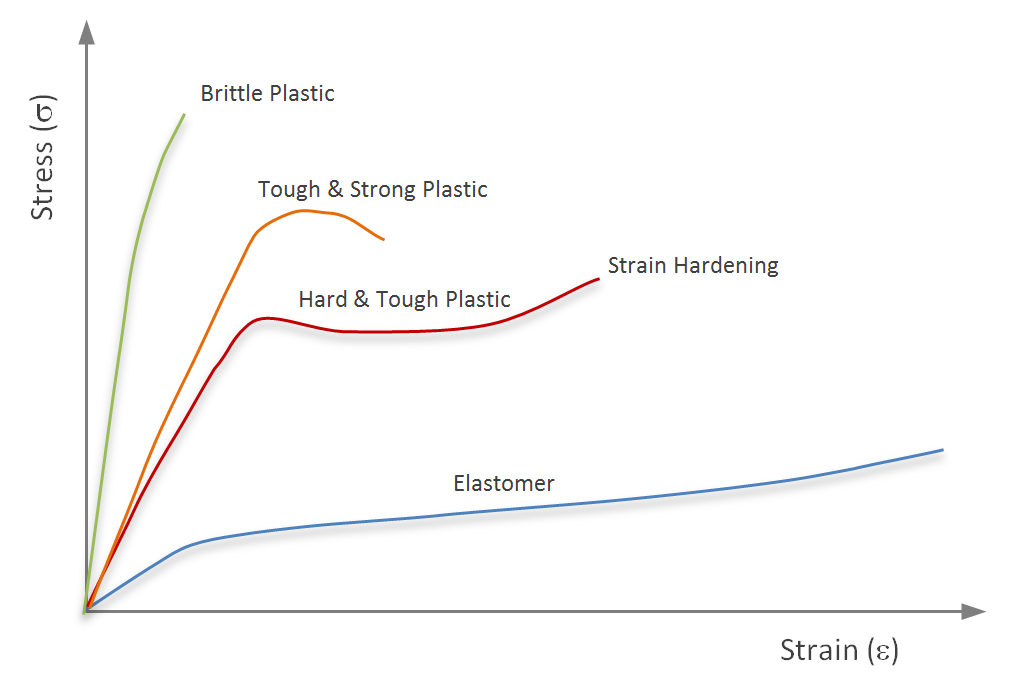TENSILE STRESS/STRAIN & BI-DIRECTIONAL DESIGN DATA

Tensile Testing of Polymers
Although single point physical property data is important and very useful for initial material selection, for some materials and applications, a more detailed analysis of mechanical behavior may be important.
- The response of thermoplastic compounds to loading is complex and can be significantly non-linear in nature.
- The change in response to loading in different temperature environments for some compounds may be valuable in the design of specific parts or applications.
- Fiber reinforced materials are not isotropic, and can have significantly different material properties in the direction of flow than they have across flow.
Most important characteristics of Polymers
One of the most important characteristics of polymers is their inherent toughness and resistance to fracture (crack propagation). It is not coincidence that the name plastic, which describes any kind of polymeric material, is similar to the word plasticity which is the propensity of a solid to undergo permanent deformation under stress.
The mechanical properties of plastic materials depend on both the strain (rate) and temperature. At low strain, the deformation of most solids is elastic, that is, the deformation is homogenous and after removal of the deforming load the plastic returns to its original size and shape. In this regime, the stress (σ) is proportional to the strain (ε):
Stress / Strain = Constant or σ = E ε
where E is the tensile (or Young’s) modulus of the plastic which is a measure of the stiffness of the material. This relationship is known has Hooke’s law. It means, when a plastic specimen is pulled at a (constant) strain rate the applied stress (or load) is directly proportional to the observed strain (or elongation). The maximum stress up to which the stress and strain remain proportional is called the proportional limit.
If a plastic material is loaded beyond its elastic limit, it does not return to its original shape and size, i.e. a permanent deformation occurs. With increasing load a point is eventually reached at which the material starts yielding. This point is known as the yield point. A further increase in strain occurs without an increase in stress.
The stress-strain behavior of a polymer greatly depends on the temperature. At very low temperature well below the glass transition temperature, brittle failure is observed as a break at low strain rate at the stress maximum. If the temperature is increased, a polymeric material changes from brittle (crazing) to ductile (yielding) behavior in deformation and fracture. This temperature is called the Brittle-Ductile Transition Temprature.
STRESS-STRAIN BEHAVIOR OF POLYMERS
 A ductile material shows a characteristic yield point followed by a drop in strength and break at lower stress but much higher strain. At this point, the material starts to undergo plastic deformation. Materials with high plasticity show strong necking and in some cases cold drawing. Beyond the yield point, the cross section in the necking region will steadily reduce until the material breaks abruptly. For some polymers, strong stretching with a stress minimum and break at a much higher stress is observed. This phenomenon is known as “strain hardening” and “stress induced crystallization“.
A ductile material shows a characteristic yield point followed by a drop in strength and break at lower stress but much higher strain. At this point, the material starts to undergo plastic deformation. Materials with high plasticity show strong necking and in some cases cold drawing. Beyond the yield point, the cross section in the necking region will steadily reduce until the material breaks abruptly. For some polymers, strong stretching with a stress minimum and break at a much higher stress is observed. This phenomenon is known as “strain hardening” and “stress induced crystallization“.
It is caused by orientation and allignment of polymer chains in the direction of the load which increases the strength and stiffness of the plastic in stretch direction and explains the observed increase in (true) stress. The opposite of strain hardening is strain softening.
Amorphous polymers, when physically aged, exhibit soemtimes true strain softening.3 In that case, the deformation process progressively removes the effect of aging which leads to a decrease in stress when the specimen is pulled at a constant strain rate. Miehe et al. postulated that the true strain softening is the result of localized shear band formation.
When the temperature exceeds the glass transition temperature, the plastic material abruptly changes its mechanical behavior. In this region, the ultimate extension can be very high at rather low loads.
In some cases, it can exceed several hundred percent before failure occurs. The behavior before break will depend on the crosslink and entanglement density; materials that are lightly crosslinked will undergo large elastic deformation prior break, whereas uncrosslinked polymers will show Viscoelastic behavior.
